Cycadofilicales / Pteridospermales
Ø Pteridospermales are a group of Fossil Gymnosperms.
Ø They are also called as Cycadofilicales (Chamberlain used the term).
Ø As the name suggests, they are the ‘Seed Ferns’.
Ø They are Gymnosperms with ‘Fern-like’ leaves which produce ‘Seeds’.
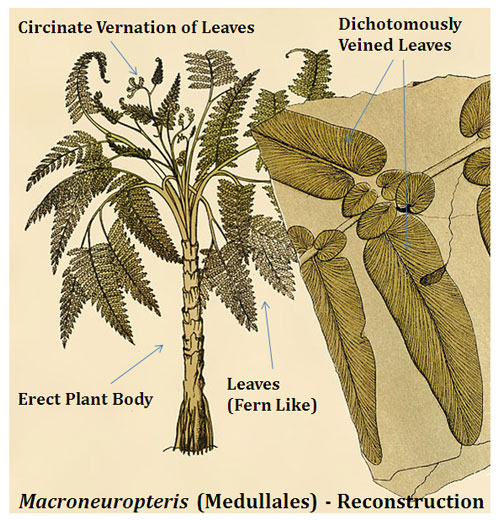
The Reconstruction of a Pteridospermales Member. Note the Erect Stem, Fern Like Leaves, Circinate Venation and Vein Pattern
Geological Horizon of Pteridospermales
Ø The Pteridospermales originated in the Upper Devonian Period of Paleozoic Era.
Ø They flourished throughout the Carboniferous and Permian Period
Ø They become completely extinct in the Mesozoic Era.
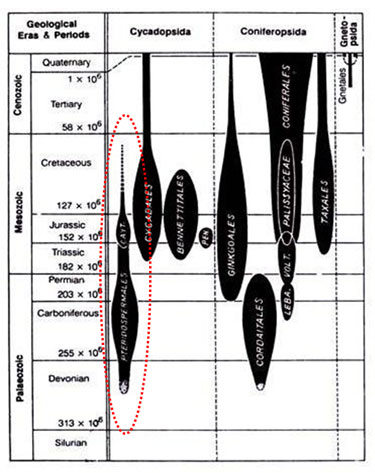
Note the red marked portion in the Geological Time Chart
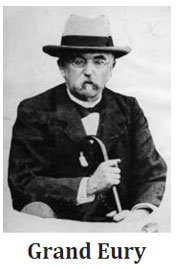
Discovery of Pteridospermales
Ø Pteridospermales were discovered and described by Grand Eury in 1877.
Examples of Pteridospermales
Lyginopteris, Medullosa, Neuropteris, Macroneuropteris, Alethopteris, Lagenostoma, Crossotheca
Characteristics of Pteridospermales
Morphology
Ø The plant body was with erect slender or weak stems.
Ø The leaves were large, pinnately compound and frond-like.
Ø Young leaves were with circinate vernation.
Ø Leaves were spirally arranged on the stem.
Ø Leaf surfaces were coated with thick cuticle.
Ø Leaf veins dichotomously branched.
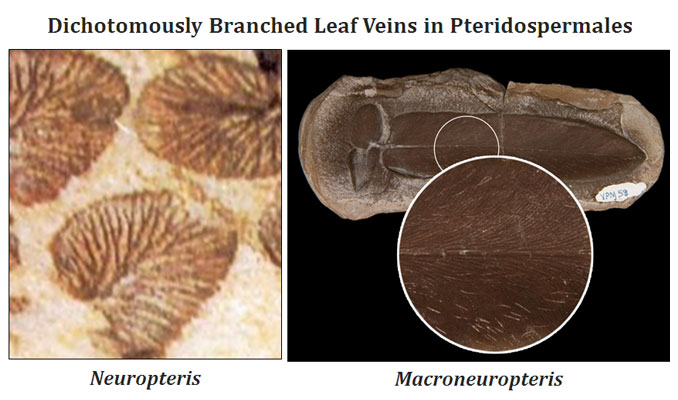
Anatomy
Ø The primary xylem was in the form of a solid or medullated protostele.
Ø Xylem usually mesarch or rarely exarch.
Ø In few forms, the xylem was reduced to circummedullary strands.
Ø In some other forms, the stele was polystelic.
Ø Wood was manoxylic (wood with a very large amount of parenchyma).
Ø Amounts of wood (secondary xylem) and phloem were very less.
Ø Wood tracheids with multi-seriate bordered pits on their radial walls.
Ø Leaf traces were also mesarch.
Ø There may be double or multiple leaf traces to each leaf.
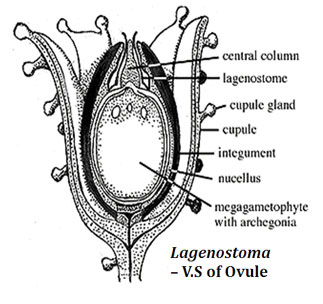
Vertical Section through the Ovule of Lagenostoma – Pteridospermales. Note the CupuleReproduction
Ø Seeds were produced directly on the modified or unmodified leaves.
Ø Cones were NOT produced in Pteridospermales.
Ø The ovules were without the annulus.
Ø Ovules were surrounded by cupule like structures.
Ø Ovular integuments free or fused with the nucellus.
Ø Ovular integuments with well-developed vascular supply.
Ø The nucellus also with vascular supply in some forms.
Ø Ovules with well-developed micropyle and pollen chamber.
Ø Megaspores were surrounded by a very thick wall.
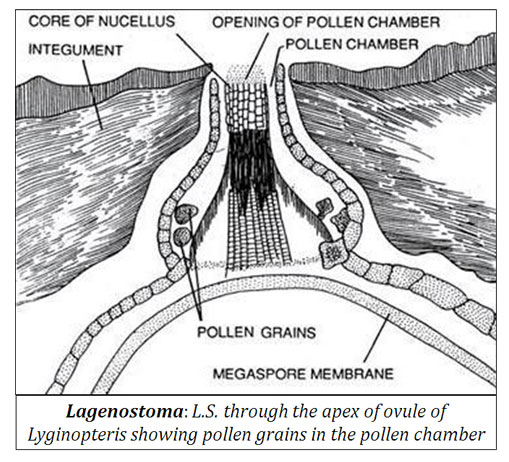
Ø The microsporangia were without the annulus.
Ø Microsporangia were often grouped into synangia.
Ø Pollen grains may be Monolete (Medullosaceae) or Trilete (Lyginopteridaceae).
Ø The pollen grains on germination produce a large number of peripheral cells enclosing a central cavity.
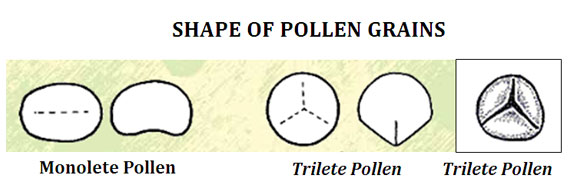
Monolete and Trilete Pollen Grains in Pteridospermales
Ø Pollen tubes were NOT produced in Cycadofilicales.
Ø Male gametes were motile (flagellated).
Ø Male gametes were directly discharged into the pollen chamber.
Ø The structure of seed resembles to that of modern-day cycads.
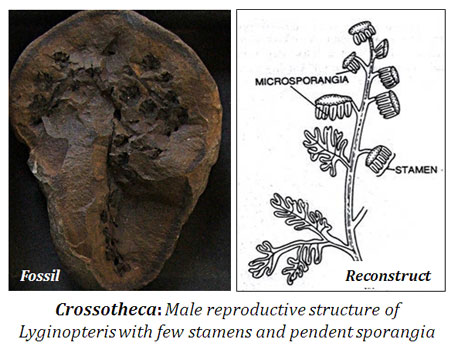
Classification of Pteridospermales
Ø According to Sporne (1965) the order Pteridospermales consists of Seven Families
(1). Lyginopteridaceae (Example: Lyginopteris)
(2). Medullosaceae (Example: Medullosa)
(3). Calamopityaceae (Example: Calamopitys)
(4). Glossopteridaceae (Example: Glossopteris)
(5). Peltasermaceae (Example: Pelserma)
(6). Corystospermaceae (Example: Umkomasia)
(7). Cyatoniaceae (Example: Cyatonia)
Inter-relationship of Pteridospermales
Ø The Pteridospermales acts as a connecting link between Ferns and typical Cycadophytes (including fossil cycads and present-day cycads).
Ø They share similar characters with Pteridophytes (ferns) and Cycadophytes.
Similarities between Pteridospermales and Ferns
Ø Large pinnately compound leaves.
Ø Dichotomously branched lateral veins.
Ø Leaves with circinate vernation.
Ø Some genera with protostele.
Ø Some genera with polystele (Medullosa).
Ø Xylem mesarch.
Ø Leaf traces mesarch.
Ø Presence of multiple leaf traces.
Ø Xylem without vessels and Phloem without companion cells.
Ø In few forms microsporangia aggregated to synangia.
Ø Microspores are trilete in some forms.
Ø Spore morphology similar to Pteridophytes.
Ø Endosporic gametophytic generation.
Ø Motile, flagellate antherozoids.
Ø Presence of archegonia.
Similarities between Ptridospermales and Cycadales
Ø Areal erect stem.
Ø Pinnately compound leaves, Circinate vernation.
Ø Mesarch leaf traces.
Ø Multiple leaf traces.
Ø Monolete microspores in Medullosa and all cycadales.
Ø Heterosporous condition.
Ø Reduction of gametophytic generation.
Ø Endosporic gametophyte.
Ø Sporangia without annulus.
Ø Motile flagellated gametes.
Ø Ovules with single integument.
Ø Integument often distinguished into three layers.
Ø Presence of Pollen chamber.
Ø Presence of archegonia.
Ø Megaspore with thick wall.
Ø The similarities between Cycadophytes and Pteridospermales suggest that the Cycadophytes may be originated from the early Pteridospermales of the Carboniferous period.
References
Bhatnagar, S.P. and Moitra, A., 1996. Gymnosperms. New Age International.
Coulter, J.M. and Chamberlain, C.J., 1910. Morphology of Gymnosperms. University of Chicago Press.
Vasishta, P.C., Sinha, A.K. and Kumar, A., 2016. Botany for Degree Students: Gymnosperms. S. Chand Pvt. Limited. Ram Nagar. New Delhi.
| You may also like... | ||
|---|---|---|
| NOTES | QUESTION BANK | COMPETITIVE EXAMS. |
| PPTs | UNIVERSITY EXAMS | DIFFERENCE BETWEEN.. |
| MCQs | PLUS ONE BIOLOGY | NEWS & JOBS |
| MOCK TESTS | PLUS TWO BIOLOGY | PRACTICAL |
You might also like…
@. Classification of Gymnosperms
@. Gymnosperms: General Characteristics
@. Difference between Pteridophytes and Gymnosperms
Pteridospermales General Characteristics PPT (Download)
Pteridospermales PPT (General Characteristics, Classification and Affinities)

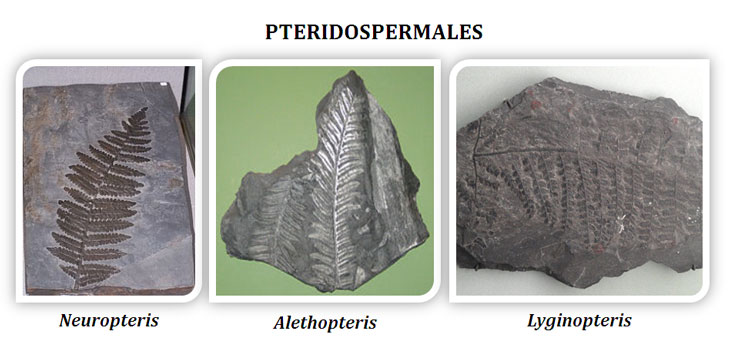
I FOUND A FLAT BLACK ROCK WITH A FERN IMPRINTED INTO IT ALSO KINDA WHITE LOOKING OUTLINES CAN YOU TELL ME MORE ABOUT THAT?